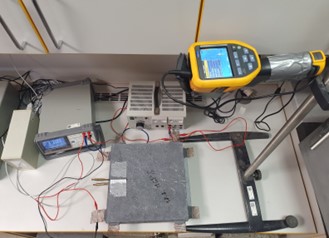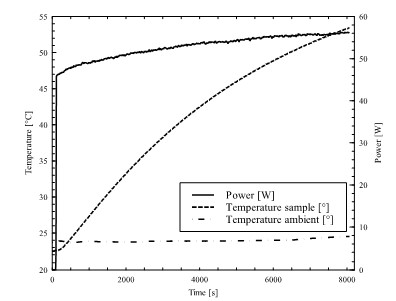
Experiment on Self-Heating Metashale Composites within the GEOSUMAT Project
Within the GEOSUMAT project, the CTU team concentrates on designing geopolymer mixtures with optimized electrical characteristics and successive testing of the newly gained functional properties of construction elements.
A part of the research within the GEOSUMAT project is focused on the design of geopolymers with new functional properties. Different electrically conductive materials (graphite, carbon fibers, carbon fiber dust) are admixed to different precursor matrices to gain the self-heating function of final composites. Designed composites are utilized within construction elements (tiles/boards) and tested in self-heating experiments.
Self-heating is a material function with the potential for de-icing and construction tempering (roads, airport runways) that can be used as an alternative to the common mechanical, salt, or other chemical treatment methods. The use of self-heating composites can reduce financial costs, increase the road safety, and reduce the considerable damage originating from the use of traditional methods during winter periods.
|
Experimental setup of self-heating experiment |
Self-heating experiment at 32.5 V RMS AC |
Throughout the experiment (metashale composite with 8% wt. graphite powder (GP)), an increase in temperature was observed on the bottom side of the sample from 22.5 to 53.4 °C and on the top side from 22.6 to 45.8 °C, with reduced maximum temperature on the top side of the material caused by heat release to the surrounding environment.
The ambient temperature and relative humidity ranged from 23.7 to 24.7 °C and 49.2 to 50.5 %, respectively, both remained stable throughout the experiment. The power output gradually increased from 45.7 to 56.5 W, corresponding to a progressive increase in the value of the electric current from 1.45 to 1.85 A.
Considering the relatively low applied voltage of 32.5 V (AC RMS), the electric resistance and current values indicated a high electrical conductivity of the material under investigation, which is favorable for self-heating function and unusual for commercially used composites without ECA. The results of the self-heating from the start to end of the experiment are shown in the following figure.
|
Images from thermography camera focused on the top side: (a) Start (b) Midpoint and (c) End of the experiment |
Thermal camera showed the gradual temperature rise and heat spread on the top of the board at the beginning, midpoint and end of the experiment The thermal imaging camera also provided a deeper insight into the evolution of heat in the studied construction tile, and observations can be used for further increase of self-heating effectivity by a different design (size, shape) and positioning of electrodes.
Based on the data and accumulated knowledge, it was concluded that the research on self-heating materials has a great potential for application in construction industry and could contribute to higher safety of buildings and roads and saving of financial resources in the future.


